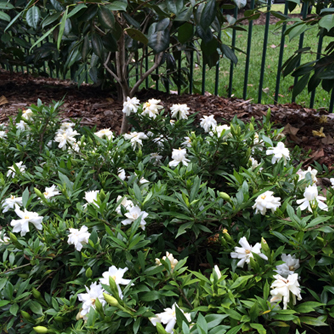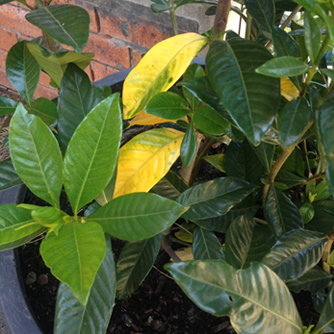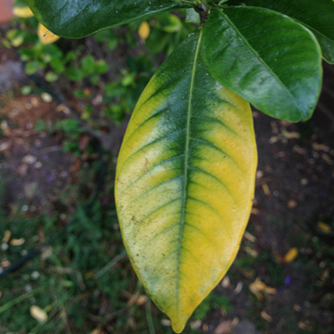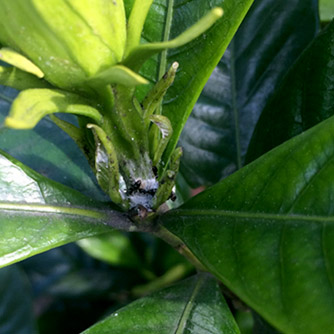Gardenias
BackGardenias have to be one of the absolute joys of gardening with their creamy white flowers and intoxicating perfume. They make a great addition to any garden as a mass planting, informal hedge, ground cover or a feature plant in a pot.
Gardenias are warm climate plants that flower throughout spring, summer and autumn. While there are a few different species it is the cultivars of Gardenia augusta that are the most commonly grown in Australia. They come in a range of sizes from the dwarf Gardenia ‘Radicans’ (50cm), the very popular Gardenia ‘Florida’ (1m) and to the large Gardenia ‘Magnifica’ (2m). Most have dark green glossy leaves but there are a few variegated forms about as well.
How To Grow Gardenias
Choose a warm, sunny position with protection from hot afternoon sun. Gardenias prefer a rich, moist soil that is slightly acidic. The soil must also be free draining as they will not tolerate waterlogging. If your soil is of poor quality then work in some compost and cow manure before planting. Apply gypsum to improve drainage in clay soils. After planting water with OCP eco-seaweed to settle plants in and then mulch with sugarcane mulch.
Being warm climate plants they aren’t so great with frosts. If you live in an area which only experiences light frosts and have a protected spot then it’s worth giving them a go. Gardenia thunbergia is more cold tolerant than the Gardenia augusta varieties.
In regions with hot dry summers keep the water up to them as they really don’t like to dry out.

Beautiful gardenia flower
Fertilising Gardenias
Gardenias are heavy feeders and like lots of iron and magnesium. Every 2-3 months from spring to autumn feed with a dose of cow manure and a bit of Certified Organic fertiliser if your soil is particularly poor.
For really strong, healthy growth and large blooms we also recommend fortnightly applications of OCP eco-aminogro and OCP eco-seaweed. It probably sounds like a lot but gardenias truly are hungry plants and you’ll be amazed at the results you get with regular liquid feeding.
Maintenance of Gardenias
Gardenias when grown in enough light will naturally produce a good shape and not require pruning. However they can be pruned if needed to reduce their height or maintain a shape eg in a hedge. Prune after a flush of flowers anytime from late summer and into autumn. In warm climates pruning can also be done in winter. Picking the flowers for indoors is a great way to tip prune and you get to enjoy more of their perfume!
Maintain a soil pH of 6-7 and keep the plants well mulched so the soil stays moist and cool. Gardenias respond best to deep, regular waterings.

Gardenia 'Florida' in full flower
Yellow Leaves on Gardenias
Yellow or pale leaves is a common problem with gardenias. Listed below are the main reasons why it can occur:
- cold weather – these are warm climate plants that react to cool winter and early spring weather by pulling nutrients out of their older leaves (making them go yellow) and then dropping them.
- old leaves – leaves have a limited lifespan and gardenias tend to drop old ones at the same time. So if you’ve got a stack of yellow leaves down low on branches but the rest of the growth is a rich green then this is what is happening. Nothing to worry about.
- incorrect soil pH – gardenias prefer acidic soils. If growing in alkaline soils gardenias have trouble accessing all the nutrients they need and yellow leaves can develop. Apply sulphur to the soil to make it more acidic. This can be a slow process so in the meantime liquid feed with OCP eco-aminogro and OCP eco-seaweed to help the plants.
- general lack of nutrients – if soil pH is acidic but the plant still looks pale or yellow all over then it’s usually just hungry. Remember these are heavy feeders and a lack of nutrition will show up quickly.

Groundcover gardenia 'Radicans' under a camellia
- specific nutrient deficiency – plants may be lacking in a particular nutrient which shows up as yellow/pale leaves with certain patterns. Sometimes it can be difficult to distinguish the exact deficiency but the most common ones are:
- magnesium – pale/yellow triangular pattern with leaf tips and edges
- iron – pale/yellow leaves but the veins remain green
- nitrogen – new growth is pale/yellow
While you can treat for the specific deficiency the best approach is to first check the soil pH is acidic and then feed the plants with a complete nutrient source. We recommend some cow manure or organic fertiliser pellets and then water in with some OCP eco-aminogro and OCP eco-seaweed.
Pests and Diseases of Gardenias
Other than yellowing leaves there are few other problems to look out for :
- Aphids, scale and mites – these pests suck nutrients from the plant. Spray with OCP eco-oil for easy control.
- Sooty mould – this is a secondary problem caused by sap sucking pests such as aphids and scale. Control with OCP eco-oil and the sooty mould will dry up and flake away.

Normal yellowing gardenia leaves
- Caterpillars – these may attack flower buds and occasionally new leaves. Spray with OCP eco-neem.
- Mealybugs – you can control these blighters by spraying with OCP eco-neem. It’s important to spray thoroughly so the solution reaches into all the crevices where mealybugs often congregate.
- Ants – if you notice lots of ants on your gardenia then it means you’ve got a sap sucker present (e.g. aphids or mealybug) and the ants are feeding on their sugary excretions. Control the sap suckers and the ants will go away. You can speed things up by applying a band of horticultural glue around the base of plant trunks to restrict their movements.
- Bud drop or failing to open – Some bud fall is normal in spring but generally it’s a sign that plants are stressed. Usually it’s due to incorrect soil moisture levels (too dry or too wet) so adjust your watering to achieve a consistent moist soil. It can also be due to pests feeding at the base of the bud. Mealybug is the number one suspect here!

Iron deficient gardenia leaves

Magnesium deficient gardenia leaves

Mealybugs being farmed by ants on gardenia


